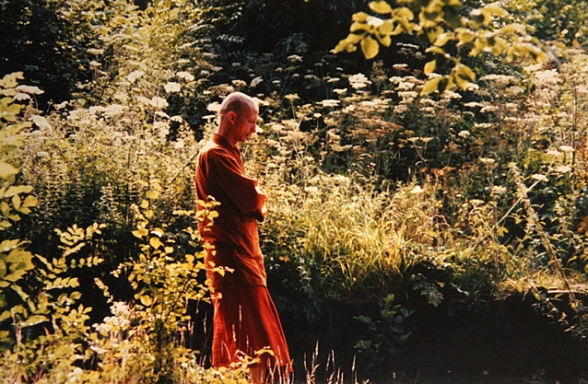 Ajahn Brahmavamso is a wonderful Theravadan monk whose wit and humor help bring the dharma alive. Because of his courageous stand on the ordination of women as Buddhist nuns, I thought it would be good to give people who are not familiar with him a feel for Ajahn Brahm’s skill as a teacher. I think this is one of the best, most inspiring metta instructions I’ve ever posted.
Ajahn Brahmavamso is a wonderful Theravadan monk whose wit and humor help bring the dharma alive. Because of his courageous stand on the ordination of women as Buddhist nuns, I thought it would be good to give people who are not familiar with him a feel for Ajahn Brahm’s skill as a teacher. I think this is one of the best, most inspiring metta instructions I’ve ever posted.
Loving-Kindness Meditation (Metta)
Ajahn Brahmavamso
Metta is the Buddhist word for “loving-kindness.” It refers to the emotion of goodwill, that which wishes happiness for another. It embraces forgiveness, because Metta says: “The door to my heart is open to you. No matter who you are or what you have done, come in.” It is that kindness which does not judge and is given freely, expecting nothing in return. The Buddha compared Metta to a mother’s love for her child (Sn, 149). A mother may not always like her child or agree with everything it does, but she will always care for her child, wishing it only happiness. Such openhearted, non-discriminating kindness is Metta.
Metta meditation is that meditation which focuses the attention on the feeling of loving-kindness, developing that beautiful transcending emotion until it fills the whole mind. There are many methods for developing Metta meditation. Here is just one way.
To Light a Fire, Start with “Kindling”—Someone or Something You Love
 One way you can develop loving-kindness meditation is by choosing some object, which you find easy to feel loving kindness toward. The simile I often use is that of lighting a fire. You need kindling to light a fire. One can’t put a match to a big log and expect the match to ignite that log. The log is far too big. So you have to find something, which will take the flame easily, something, which is easy to light. It could be some of the firelighters you get for barbecues, or paper, or straw — anything that takes the fire very easily will do. You build up the first flames of loving-kindness on that kindling and then later one can put on more solid pieces of wood.
One way you can develop loving-kindness meditation is by choosing some object, which you find easy to feel loving kindness toward. The simile I often use is that of lighting a fire. You need kindling to light a fire. One can’t put a match to a big log and expect the match to ignite that log. The log is far too big. So you have to find something, which will take the flame easily, something, which is easy to light. It could be some of the firelighters you get for barbecues, or paper, or straw — anything that takes the fire very easily will do. You build up the first flames of loving-kindness on that kindling and then later one can put on more solid pieces of wood.
First of all one uses just twigs and then branches, then you can put big logs on that fire. It’s always the case that only when there’s a big roaring fire — really strong and very hot — only then can you put on the big “sappy logs.” The big sappy logs in this simile stand for your enemies. Sometimes for many of you, the biggest sappy log is yourself! When you find the fire of loving-kindness is very strong, you can put yourself on that fire, “dry out” and ignite the biggest, sappiest log of all.
 Once the fire is strong, you can give loving-kindness towards even your worst enemies. It may surprise you that you can actually do this. You think of this person towards whom you’ve always had anger and wanted revenge, and you find that you are now in a mind state where you can actually love them, really give them goodwill. And you’re not playing around either. It’s actually happening! This is the result of the gradual process of development of this emotion called “loving-kindness”.
Once the fire is strong, you can give loving-kindness towards even your worst enemies. It may surprise you that you can actually do this. You think of this person towards whom you’ve always had anger and wanted revenge, and you find that you are now in a mind state where you can actually love them, really give them goodwill. And you’re not playing around either. It’s actually happening! This is the result of the gradual process of development of this emotion called “loving-kindness”.
Now as to the “kindling”, this is where you use your power of imagination and visualization together with your mental commentary. Here you encourage the commentary, but you keep your commentary just to a certain topic. You’re, as it were, “psyching yourself up” to develop loving-kindness towards a small visual object, an imaginary object. Don’t be afraid of imagination, because visualization and imagination are tools of the mind that you can use to your benefit.
 Keeping your eyes closed, imagine in front of you a small kitten or a puppy or a baby or whatever you find it easy to generate loving-kindness towards. (I personally like using a small kitten.) Imagine it to be abandoned, hungry, afraid, and in your mind open your heart to it. Take it up gently, in imaginary arms, and use inner speech to say: “May you not feel so afraid. Be at peace. May you be happy. I will look after you, be your friend and protector. I care for you. Whatever you do, wherever you go, my heart will always welcome you. I give you my love unconditionally, always.”
Keeping your eyes closed, imagine in front of you a small kitten or a puppy or a baby or whatever you find it easy to generate loving-kindness towards. (I personally like using a small kitten.) Imagine it to be abandoned, hungry, afraid, and in your mind open your heart to it. Take it up gently, in imaginary arms, and use inner speech to say: “May you not feel so afraid. Be at peace. May you be happy. I will look after you, be your friend and protector. I care for you. Whatever you do, wherever you go, my heart will always welcome you. I give you my love unconditionally, always.”
Say those words inside (or similar one’s that you make up) with full meaning, even though it is to a being only in your imagination. Say them many times until you feel the joy of Metta arise in you heart like a golden glow. Stay with this exercise until the feeling of Metta is strong and stable.
Metta Includes Compassion
Loving-kindness includes compassion, so you can use compassion to generate Metta. You look at that imaginary being and focus on its suffering, real or potential. You see the fact that it is subject to pain — not just physical pain but also the mental pain of loneliness and rejection. You see how very vulnerable it is. When I do this with my little imaginary kitten I always think that there’s no one else in the whole world to look after that small being. If I don’t look after it, if I don’t take it in, I just imagine what sort of death that little being is going to have — cold, rejected, hungry, thirsty and sick. When I start to see the suffering (the dukkha), in that being and how it is so vulnerable to pain, then straight away it encourages compassion in me towards it. I want to protect and care for it.
 As soon as that compassion, that sense of looking after the little being comes up, it’s very easy at the same time to have loving-kindness, (which is basically goodwill). Compassion is goodwill towards someone who’s suffering. In this instance it’s goodwill to ease the suffering of that imaginary being, and if its not suffering, to make its happiness even more delightful. I deliberately generate feelings of goodwill, of kindness, of compassion and of care.
As soon as that compassion, that sense of looking after the little being comes up, it’s very easy at the same time to have loving-kindness, (which is basically goodwill). Compassion is goodwill towards someone who’s suffering. In this instance it’s goodwill to ease the suffering of that imaginary being, and if its not suffering, to make its happiness even more delightful. I deliberately generate feelings of goodwill, of kindness, of compassion and of care.
All of these words are centering in on this concept of “loving-kindness”, and I enter into a commentary with myself at this time, just imagining what might happen to that being, imagining looking after it, saying words of kindness, of protection. I do imaginary exercises like getting eye contact with that little being. When you can actually contact the imaginary being’s eyes it becomes very emotional. Then I just keep on developing those images. I continue that commentary until such time that the loving-kindness towards that imaginary being is really, really strong.
You will find — at least I find anyway — that it’s so much easier to light a fire of loving-kindness on such easy kindling. First of all, my imaginary kitten is a lovely furry animal. It’s imaginary, so I can make it whatever I want. It’s young. If it were actually real even little kittens can sometimes be pests. But if it’s imaginary you’ve got full control over it to make it as furry, or as soft as you like. It purrs at the right time, and it doesn’t poo on your lap. So you can do everything you want, just to make it a very nice little being. It’s imaginary. You’ve got control over it.
Choose An Object You Can Relate To
 One person I know didn’t have much empathy towards little animals, nor did she like children. What she did was very innovative. She’d just been planting some small flowers in some pots in her house; so she just imagined a small plant in the earth. Just like the little kitten or the puppy, the plant is also a being that needs care and protection. She put all her motherly instincts, which she didn’t really have towards children, towards that little plant, nurturing it and just imagining it growing.
One person I know didn’t have much empathy towards little animals, nor did she like children. What she did was very innovative. She’d just been planting some small flowers in some pots in her house; so she just imagined a small plant in the earth. Just like the little kitten or the puppy, the plant is also a being that needs care and protection. She put all her motherly instincts, which she didn’t really have towards children, towards that little plant, nurturing it and just imagining it growing.
When it was a young seedling, it was just so tender and so easily hurt and broken. It had a long way to go before it was a full fledged flower. She imagined herself nurturing it, protecting it, loving it, caring for it until such time that the little flower burst forth and repaid her kindness with this beautiful smile of a flower in bloom. She really “got off” on that. That was for her the first time that meditation actually seemed to work. It was the first time she wasn’t waiting for me to ring the bell. So this is another way of developing loving-kindness, instead of towards an animal or a human being, towards even a plant. And you can do that.
The point is, as long as you are nurturing this emotion and making it grow, you’re allowed to use your commentary, and it’s good to use it at this point to keep the fire burning. When you put a match to a piece of paper, you’ve got to blow; you’ve got to fan. You’ve got to keep it going.
 Sometimes you need two or three matches to get it alight. You work until the fire is going, and once loving-kindness is going, always remember to experience the warmth from time to time. So you’re working to get the fire going, but you’re also pausing now and again, to experience the result of your work. And as you see the result of your work, it gives you encouragement.
Sometimes you need two or three matches to get it alight. You work until the fire is going, and once loving-kindness is going, always remember to experience the warmth from time to time. So you’re working to get the fire going, but you’re also pausing now and again, to experience the result of your work. And as you see the result of your work, it gives you encouragement.
So you’re just using this imaginary “kindling” as a means to develop loving-kindness, to get it started. As you go along, quite naturally you’ll be aware of the feel of loving-kindness. When the flame starts to take and there’s a fire starting, you can feel its warmth. Loving-kindness when it gets started is a very pleasurable emotion. Once you start to feel its warmth, then you really get into it.
How Metta Grows and Expands its Horizons
Now let go of the imaginary being, and imagine in its place a real person, someone very close to you emotionally, your best friend maybe. Choose someone to whom you also find it easy to generate and maintain loving-kindness towards. With inner speech say to them: “May you live in happiness. I sincerely wish you joy. I give you my love, without discrimination. You will always have a place in my heart. I truly care for you.” — or similar words of your own design. Use whatever arouses the warm glow of Metta in you heart. Stay with this person. Imagine they are right before you until the Metta glows bright and constant around them.
When the Metta glows bright and constant, let go of the image of that person. Substitute another close acquaintance, creating the feeling of Metta around them using your inner speech in the same way: “May you live in happiness…”
Next substitute a whole group of people, perhaps all of the people who are in the house you are in. Develop the caring glow of Metta around them, all in the same way. “May you all be happy and well…”
A Lotus of Love in Our Hearts
 See if you can imagine Metta to be a golden radiance coming from a beautiful white lotus flower in the middle of your heart. Allow that radiance of loving-kindness to expand in all directions, embracing more and more living beings, until it becomes boundless, filling up all that you can imagine. “May all living beings, near or far, great or small, be happy and at peace…” Bathe the whole universe in the warmth of the golden light of loving-kindness. Stay there for a while.
See if you can imagine Metta to be a golden radiance coming from a beautiful white lotus flower in the middle of your heart. Allow that radiance of loving-kindness to expand in all directions, embracing more and more living beings, until it becomes boundless, filling up all that you can imagine. “May all living beings, near or far, great or small, be happy and at peace…” Bathe the whole universe in the warmth of the golden light of loving-kindness. Stay there for a while.
Now imagine yourself, as if looking in a mirror at yourself. Say with your inner speech, with full sincerity:
“I wish me well. I now give myself the gift of happiness. Too long the door to my heart has been closed to me; now I open it. No matter what I have done, or will ever do, the door to my own love and respect is always open to me. I forgive myself unreservedly. Come home. I now give myself that love which does not judge. I care for this vulnerable being called ‘me’. I embrace all of me with the loving-kindness of Metta…”
Invent your own words here to let the warmth of loving-kindness sink deep inside you, to that part which is most frightened. Let it melt all resistance until you are one with Metta, non-limiting loving-kindness, like a mother to her child.
When you feel it is time to conclude, pause for a minute or two to reflect on how you feel inside. Notice the effect that this meditation has had on you. Metta meditation can produce heavenly bliss. Now imagine that golden glow of Metta one more time, originating from the beautiful white lotus in your heart. Gently draw that golden light back into the lotus, leaving the warmth outside. When the glow is a tiny ball of intense light in the center of the lotus, gently close the petals of the lotus, guarding the seed of Metta within your heart, ready to be released again in your next Metta meditation. Open your eyes and get up slowly.
Recapitulation
 Now to recapitulate what we’ve covered so far: when you practice the above method of Metta meditation, it is helpful to use easy objects at the beginning. Again Metta meditation is like lighting a fire. You start by using some paper and kindling which easily takes the flame. Once that is alight, you put on some thicker sticks, and when these are burning well, you add some bigger pieces of wood. Eventually, once the fire is established, you can put on the big pieces of fuel.
Now to recapitulate what we’ve covered so far: when you practice the above method of Metta meditation, it is helpful to use easy objects at the beginning. Again Metta meditation is like lighting a fire. You start by using some paper and kindling which easily takes the flame. Once that is alight, you put on some thicker sticks, and when these are burning well, you add some bigger pieces of wood. Eventually, once the fire is established, you can put on the big pieces of fuel.
When the fire is roaring you can even put on a big, wet and sappy log, and there is enough heat for that to catch light and burn too. In this simile, the “big, wet and sappy log” stands for your “enemy,” someone you find it especially hard to forgive and be kind to. This enemy is often yourself. Once Metta has been established on the easy objects, though, you will be surprised at how even the “enemy” can “take the flame” of Metta. You find, in this way, that you can actually love your enemy.” Ajahn Brahmavamso




 2010/01/08
2010/01/08 



This is the best meditation on Metta I have ever read. Thank you.
Spreading Metta is the surest way to survive terribly catastrophic period which comes from 2012 -2014. Unfortunately many people become suicidal, go on denial etc. Those who maintain human dignity will be protected by Dhamma, that is a norm of the world.
Thank you so much for this post Steven. I truly believe that living and practising Metta is the most important, wonderful and inspiring “thing” a person can do to benefit themselves and thus, the rest of this wonderful world and it’s beings. _/|\_
As I read this lovely article, another thought came to me. I have recently noticed it is easier to feel that kind of uncluttered love toward others who trouble me, if I am finally in a state where I don’t need anything from them. If I wish I had their respect and/or affection, whatever, and I pine for their affection, like say a family member who is cold and unloving, uninvolved with people, and I crave a fuller relationship with them, it is hard to feel loose and loving toward them, but if I come to realize that I don’t need anything from them, I am fine with or without them, then the love and generous feelings can flow unimpeded. I guess it is the unconditional thing. I wonder if that kind of love is good enough, or is it in some way corrupted by something I am not seeing? It certainly feels like a relief to not need their affection any more. Fine with, fine without. Gentlenurse http://myafterlifestory.wordpress.com
This approach to Metta Meditation is indeed Liberating! I suggest reading it altogether with the excellent exposure of Dhamma we find in the book “Mindfulness Bliss and Beyond”, which I think is the source of this text, right?
The Amazon link is: http://www.amazon.com/Mindfulness-Bliss-Beyond-Meditators-Handbook/dp/0861712757
Wonderful post Steve. I read it yesterday and found it accompanied me throughout the day. Developing loving kindness towards other beings burns away my own struggles and pain. It is amazing how that works…
Yet another post to copy and keep and of course to practice its content! Thank you for your generous sharing – Even to me Ajahn Brahmavamso’s way of how to develop Metta is very adaptable because it is so visual and also so uncomplicated. (I first came across the expression ‘Metta’ here on your pages 🙂
Snædís
Hey Snædís! Sorry for my delay in thanking you. I’m so glad you, and apparently quite a few others, found it inspiring. I was sure helped by working with it again, and it continues to brighten my metta, too.
That’s cool that I introduced you to the expression “metta,” though it’s clear you’ve been “practicing” love for quite a while now. 🙂
Best wishes,
Steve
Thanks for this one. . .have read it twice and truly beautiful and so very rich with goodness. . .
You’re most welcome. I myself had not read it in some time, but when I found out what was going on with Ajahn Brahm and his ordination of women, I rediscovered this wonderful teaching. So glad I could share it. A slew of “sparrows” arrived in my in-box today, but I haven’t had time to admire them yet. 🙂
Best wishes,
Steve
This book on Metta by a monk has helped me come to understand metta better than anything I’d read before, similar to the article above.
Click to access allmetta.pdf
Thanks for the post.